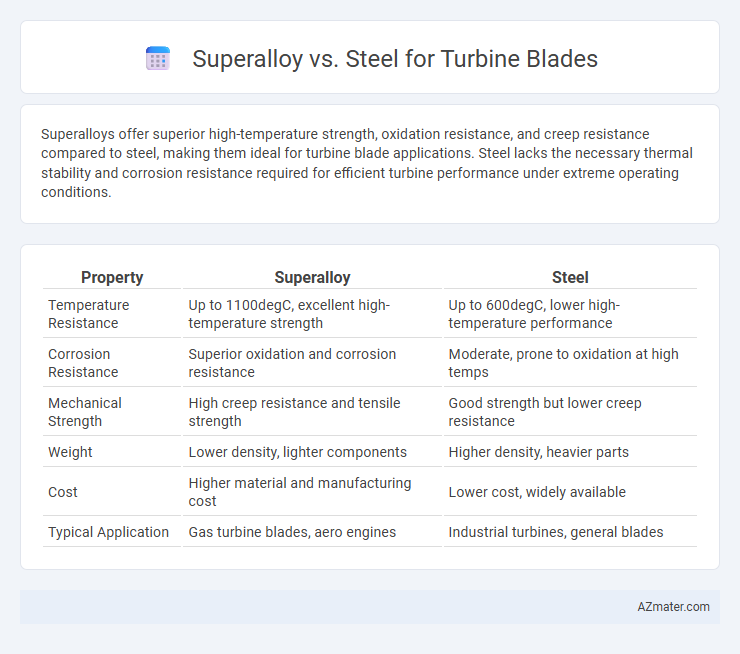Superalloys offer superior high-temperature strength, oxidation resistance, and creep resistance compared to steel, making them ideal for turbine blade applications. Steel lacks the necessary thermal stability and corrosion resistance required for efficient turbine performance under extreme operating conditions.
Table of Comparison
| Property | Superalloy | Steel |
|---|---|---|
| Temperature Resistance | Up to 1100degC, excellent high-temperature strength | Up to 600degC, lower high-temperature performance |
| Corrosion Resistance | Superior oxidation and corrosion resistance | Moderate, prone to oxidation at high temps |
| Mechanical Strength | High creep resistance and tensile strength | Good strength but lower creep resistance |
| Weight | Lower density, lighter components | Higher density, heavier parts |
| Cost | Higher material and manufacturing cost | Lower cost, widely available |
| Typical Application | Gas turbine blades, aero engines | Industrial turbines, general blades |
Introduction: Turbine Blade Material Selection
Turbine blade material selection is critical for ensuring durability, efficiency, and performance under extreme operating conditions. Superalloys, known for their exceptional high-temperature strength, corrosion resistance, and thermal stability, outperform conventional steel in sustaining the rigorous environment of turbine engines. Compared to steel, superalloys maintain structural integrity at temperatures exceeding 1000degC, making them the preferred choice for modern gas turbines and aerospace applications.
Overview of Superalloys and Steel
Superalloys, primarily nickel-based, are engineered for extreme high-temperature strength, corrosion resistance, and mechanical stability, making them ideal for turbine blade applications where thermal and mechanical stresses are intense. Steel, while cost-effective and strong at moderate temperatures, lacks the high-temperature oxidation resistance and creep strength necessary for turbine blades operating in harsh environments. The superior temperature tolerance and fatigue resistance of superalloys enable longer turbine blade life and enhanced performance in aerospace and power generation turbines.
Mechanical Properties Comparison
Superalloys exhibit superior mechanical properties compared to steel for turbine blade applications, including higher tensile strength, creep resistance, and oxidation resistance at elevated temperatures. Their excellent fatigue resistance and ability to maintain structural integrity under extreme thermal and mechanical stress make them ideal for high-performance turbine environments. In contrast, steels generally offer lower temperature capabilities and reduced lifespan under similar operational conditions.
High Temperature Performance
Superalloys exhibit superior high temperature performance compared to steel due to their enhanced creep resistance, oxidation resistance, and thermal stability essential for turbine blade applications. Nickel-based superalloys maintain mechanical strength and microstructural integrity at temperatures exceeding 1000degC, whereas steel typically degrades above 600-700degC. This thermal resilience enables superalloy turbine blades to achieve higher efficiency and durability in gas turbines and aerospace engines.
Corrosion and Oxidation Resistance
Superalloys exhibit superior corrosion and oxidation resistance compared to steel, making them ideal for turbine blade applications exposed to extreme environments. Their composition, typically rich in nickel, cobalt, and chromium, forms a stable oxide layer that protects against high-temperature oxidation and corrosive gases. In contrast, steel lacks this protective oxide scale under turbine operating conditions, leading to faster degradation and reduced blade lifespan.
Manufacturing and Machinability
Superalloys offer superior high-temperature strength and corrosion resistance essential for turbine blades but present challenges in manufacturing due to their hardness and tendency to work-harden, requiring specialized machining tools and processes such as EDM and laser cutting. Steel, while easier to machine with conventional equipment thanks to its lower hardness, lacks the thermal stability and oxidation resistance necessary for high-temperature turbine applications. Advanced coating technologies and heat treatment can improve steel's performance but still fall short of the durability and precision machining needs met by superalloys in turbine blade production.
Cost and Economic Considerations
Superalloys used for turbine blades offer superior high-temperature strength and corrosion resistance, but their complex manufacturing processes and raw material costs significantly increase overall expenses compared to steel. Steel, while more affordable and easier to produce, often requires more frequent replacement and maintenance due to lower thermal durability, impacting long-term operational costs. Evaluating the cost-effectiveness of turbine blades requires balancing initial investment against lifecycle performance and maintenance demands in harsh operating environments.
Lifespan and Maintenance Requirements
Superalloys offer superior lifespan compared to steel for turbine blades due to their excellent resistance to high-temperature oxidation, creep, and thermal fatigue. Steel turbine blades generally require more frequent maintenance and shorter replacement intervals because they are less resistant to extreme operating conditions. The advanced metallurgy of superalloys reduces downtime and maintenance costs, making them more efficient for long-term turbine operation.
Common Applications in Turbine Industry
Superalloys, primarily nickel-based, dominate turbine blade manufacturing in jet engines and gas turbines due to their exceptional high-temperature strength, oxidation resistance, and creep resistance, enabling operation in extreme environments. Steel alloys, such as stainless steel and high-strength steels, are commonly used in lower-temperature sections of turbines, including industrial steam turbines and older gas turbines, where cost efficiency and adequate mechanical properties suffice. The turbine industry prefers superalloys for critical hot-section components, while steel remains favored for structural parts and less demanding turbine zones.
Conclusion: Choosing the Optimal Material
Superalloys outperform steel in turbine blade applications due to their superior high-temperature strength, oxidation resistance, and creep resistance, which are critical in sustaining performance in extreme operating environments. Steel blades, while more cost-effective and easier to manufacture, typically lack the necessary thermal stability and mechanical durability for long-term use in high-temperature turbines. Selecting superalloys ensures enhanced reliability and efficiency in turbine engines, justifying their higher material and processing costs.

Infographic: Superalloy vs Steel for Turbine Blade
 azmater.com
azmater.com